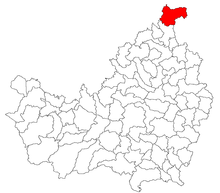Chiuieşti
|
Chiuieşti Pecsétszeg |
||||
|
||||
| Basic data | ||||
|---|---|---|---|---|
| State : |
|
|||
| Historical region : | Transylvania | |||
| Circle : | Cluj | |||
| Coordinates : | 47 ° 18 ' N , 23 ° 52' E | |||
| Time zone : | EET ( UTC +2) | |||
| Height : | 324 m | |||
| Area : | 112 km² | |||
| Residents : | 2,332 (October 20, 2011) | |||
| Population density : | 21 inhabitants per km² | |||
| Postal code : | 407215 | |||
| Telephone code : | (+40) 02 64 | |||
| License plate : | CJ | |||
| Structure and administration (as of 2016) | ||||
| Community type : | local community | |||
| Structure : | Chiuiești, Dosu Bricii , Huta , Măgoaja , Strâmbu , Valea Cășeielului , Valea lui Opriș | |||
| Mayor : | Gavril Mihuț ( PNL ) | |||
| Postal address : | Str. Principală, no. 150 loc. Chiuieşti, jud. Cluj, RO-407215 |
|||
| Website : | ||||
Chiuiești [ ˈciuieʃtʲ ] ( Hungarian Pecsétszeg ) is a municipality in Cluj County , in Transylvania , Romania .
The place is also known by the Romanian names Chiueşti , Chiuleşti and Tiuieşti , and the Hungarian Pechetzege .
Geographical location
The municipality of Chiuieşti is located northwest of the Transylvanian Basin in the Dealurile Ciceului and is the northernmost municipality in the Cluj district. On the Sălătruc brook - a right tributary of the Someș (Somesch) - and the Drum național 18B , the community center is located 19 kilometers north of the city of Dej (Deesch) and about 75 kilometers north of the district capital of Cluj-Napoca (Klausenburg) .
history
Chiuieşti was first mentioned in documents in 1467. In the Middle Ages , Romanian aristocrats settled in the place and, like the hamlet of Valea lui Opriș, it belonged to Ocna Dejului (salt village) .
In the Kingdom of Hungary , today's municipality belonged to the Dés chair district in the Szolnok-Doboka County , then to the historical Someș district and, from 1950, to today's Cluj district.
population
The population of the municipality developed as follows:
| census | Ethnic composition | ||||
|---|---|---|---|---|---|
| year | population | Romanians | Hungary | German | other |
| 1850 | 2,982 | 2,786 | 22nd | - | 174 |
| 1920 | 3,866 | 3.711 | 11 | 4th | 140 |
| 1956 | 4,040 | 3,989 | 4th | - | 47 |
| 2002 | 2,769 | 2,767 | - | - | 32 |
| 2011 | 2,332 | 2,265 | 3 | - | 64 (Roma 25) |
Since 1850, the highest number of inhabitants and that of the Romanians in 1956 have been determined in the area of today's municipality. The highest population of the Magyars (39) in 1941, that of the Roma (52) in 1850 and that of the Romanian Germans was registered in 1920.
Attractions
- The wooden church Sfânta Cruce of the Strâmbu monastery , built at the end of the 18th century, is a listed building.
- In the incorporated village of Strâmbu (Hungarian Horgospataka ) the church Sf. Arhangheli in the 17th century and the wooden church Sf. Apostoli Petru și Pavel built in the 18th century are a listed building.
- In the unincorporated village of Valea Căşeielului the nunnery Căşiel and its wooden church Inălţarea Sf. Cruci .
Personalities
- Grigore Pintea (1670–1703), born in Măgoaja (Hungarian Hollómező ), Romanian folk hero.
- Ioan Giurgiu Patachi (1682–1727), born in Strâmbu (Hungarian Horgospataka ), was Romanian-Greek-Catholic bishop of the Diocese of Fogarasch.
Web links
Individual evidence
- ↑ 2011 census in Romania ( MS Excel ; 1.3 MB)
- ↑ Chiuieşti at arcanum.hu
- ↑ a b c Heinz Heltmann, Gustav Servatius (ed.): Travel Guide Siebenbürgen . Kraft, Würzburg 1993, ISBN 3-8083-2019-2 , p. 517 .
- ↑ Censuses 1850–2002, last updated November 2, 2008 (PDF; 1 MB; Hungarian)
- ↑ a b List of historical monuments of the Romanian Ministry of Culture, updated 2015 (PDF; 12.7 MB; Romanian)
- ↑ Information on the Church Sf. Arhangheli in Strâmbu from biserici.org (Romanian). Retrieved September 29, 2017
- ↑ Information on the wooden church Sf. Apostoli Petru și Pavel in Strâmbu from biserici.org (Romanian) accessed on September 29, 2017
- ↑ Information on the wooden church Inălțarea Sf. Cruci in Valea Cășeielului from biserici.org (Romanian). Retrieved September 29, 2017
- ↑ Bust of the folk hero Grigore Pintea
- ↑ The brave Pintea - the truth behind the legend and the film Pintea at istorie-pe-scurt.ro (Romanian) accessed on September 26, 2017




